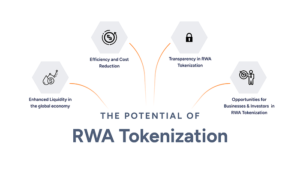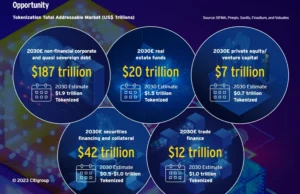The concept of tokenization has emerged as a revolution, preparing traditional markets for a new era of digital assets. Tokenization involves converting real-world assets into digital tokens and storing them on a blockchain or other distributed ledger technology. This approach extends beyond physical assets and may include real estate, data, intellectual property, artworks, etc. It is considered a next-generation format for assets that opens up new avenues for investment and financial transactions.
The acceptance of tokenization by financial leaders is evident in recent developments. The World Bank issued a digital bond using Euroclear’s DLT solution, HSBC tokenized gold for its clients, and BlackRock just launched its BTC ETF (IBIT). These initiatives mean the growing recognition and adoption of tokenization in the financial sector.
Why is the tokenization of RWAs a rapidly growing trend?
There are several advantages to transforming Real-World Assets into tokens, making it a popular trend in the digital world. In fact, it’s widely considered one of the most growing trends for the year 2024. Let’s discuss some of them…

-One of the advantages of tokenized real-world assets is the ability to trade them 24/7 on cryptocurrency exchanges. Unlike traditional markets with set trading hours, this provides traders with freedom and flexibility.
-Moreover, the transparency of tokenization well known in blockchain technology enhances investor confidence, significantly reducing the risk of fraud and ownership conflicts. The decentralized nature of the blockchain ensures that ownership tokens are secure and transparent, fostering trust in the ecosystem.
-Tokenization brings a significant reduction in costs made by trading traditional assets. Traditional processes involve paperwork and fees which sometimes are high costs. Digital trading does not include this kind of expense and if it includes any kind of it- it is surely much lower.
-However, it’s crucial to note that any tokenization project must keep up with local laws and regulations. This ensures a legal framework that safeguards the interests of all parties involved and provides their trust.
Data Tokenization – Enhancing Data Security
Beyond traditional assets, data tokenization is an especially growing trend in the digital blockchain world. As we recognize the importance of data and its preservation, it is not surprising to witness this new trend. This process involves converting sensitive data into tokens while at the same time saving its value linked to the original data and improving data security. The purpose of data tokenization includes securing sensitive information from unauthorized access, minimizing the risk of data breaches, and making data handling easier. By replacing sensitive data with distinct tokens, the potential impact of security incidents is mitigated.

Real Estate Tokenization – Digital Property Ownership
Real estate tokenization marks a significant shift in how we perceive property ownership. This process involves converting real estate assets into digital tokens through smart contracts on a blockchain. Each token represents a fractional ownership of the underlying property, providing individuals with the opportunity to invest in real estate without the traditional barriers. Token holders also enjoy the right to harvest the benefits of the property. While it has its advantages, particularly in terms of trading fees, it’s important to acknowledge that there is still some skepticism associated with this kind of trading. Building trust in such methods may take some time.
In conclusion, the tokenization of real-world assets represents a transformation in the financial world. As financial leaders and institutions embrace this new technology, the potential for tokenized assets, whether in digital bonds, gold, or real estate, continues to expand. It is a new opportunity for investors with a vision of the future!
